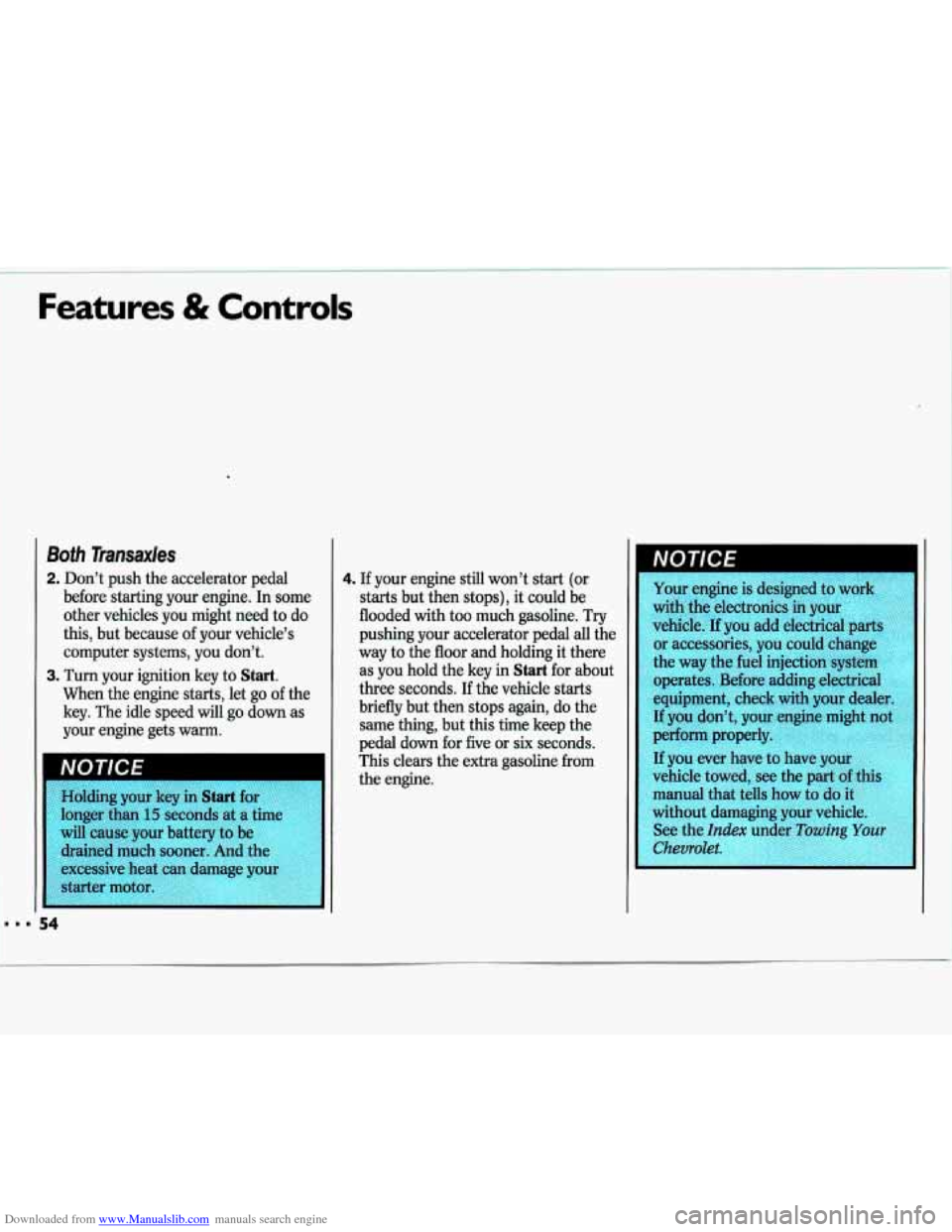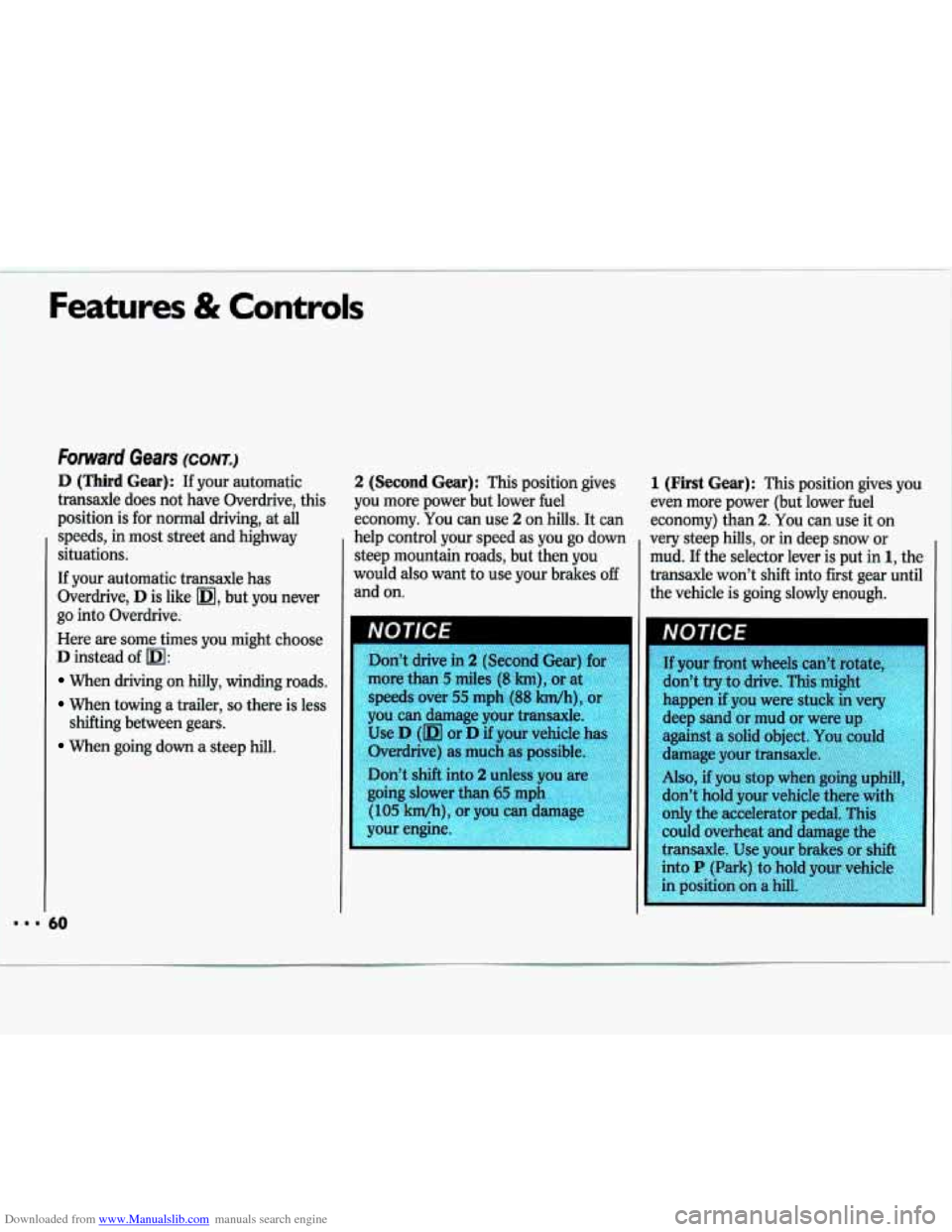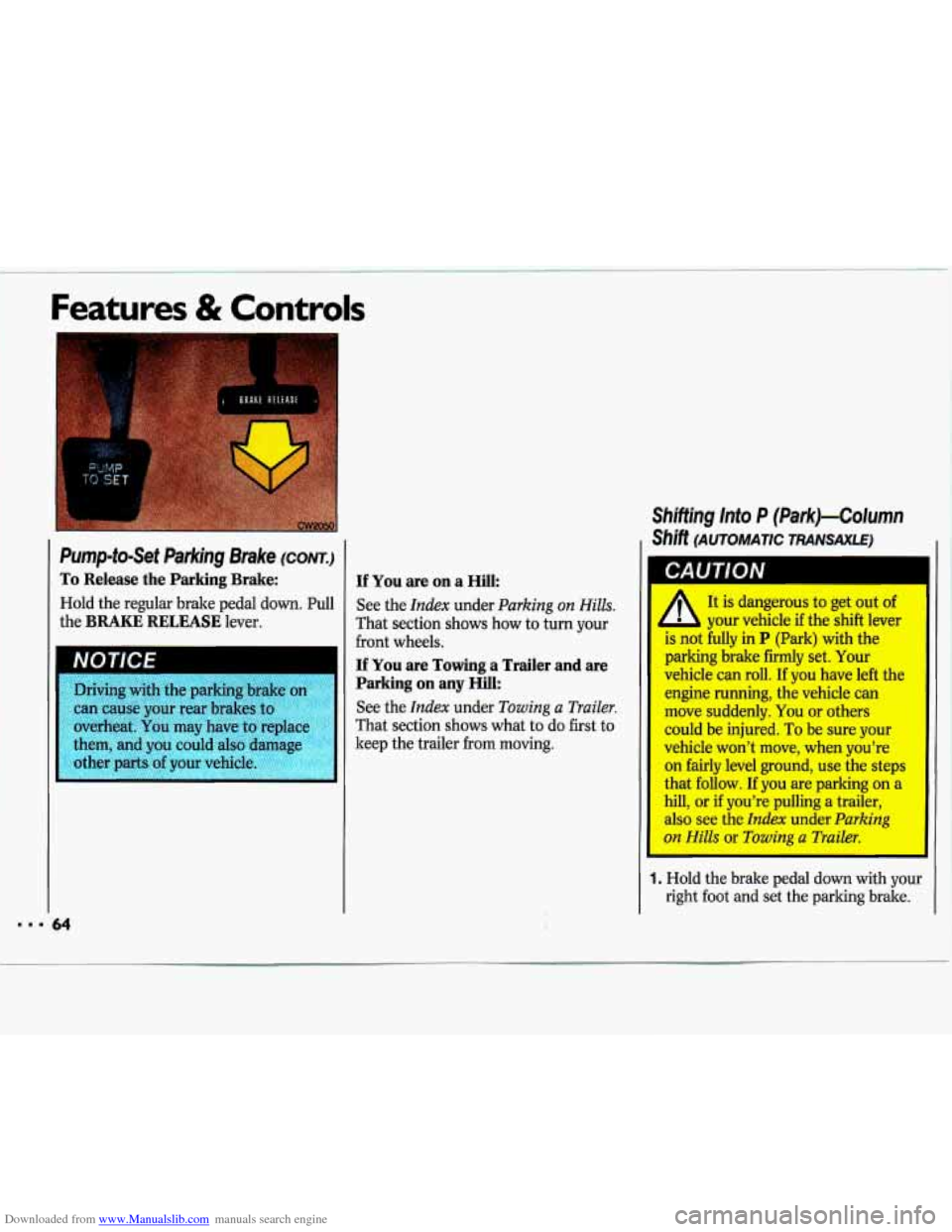Page 17 of 324
Downloaded from www.Manualslib.com manuals search engine Seatback Latches
In 2-door Chevrolets, the front seat
folds forward to let people get into the
back seat.
Your seatback
will move back and forth
freely, unless you come
to a sudden
stop. Then it will lock in place.
There’s one time the seatback may not
fold without
some help from you. That’s
if your vehicle is parked facing down a
fairly steep hill.
To fold a seatback forward, push the
seatback toward the rear as you lift this
latch. Then the seatback will fold
forward. The latch must be down for
the seat to work properly.
I
. Safety BeS:
Ilzeyke For Everyone
This part of the manual tells you how to
use safety belts properly. It also tells
you some things you should not do with
safety belts.
Page 41 of 324
Downloaded from www.Manualslib.com manuals search engine Children who aren't buckled up can
strike other people who are. Never do this.
Here two children are I - wearing the same belt. The belt
can't properly spread the impact
forces.
In a crash, the two children
-I be crushed together and
-,-iously injured.
A belt must be
I used bv onlv one Derson at a time.
r
Q: What if a child is wearing a lap-
shoulder belt, but the child
is so
small that the shoulder belt is very
close to the child's face
or neck?
A: Move the child toward the center of
the vehicle, but be sure that the
shoulder belt still is
on the child's
shoulder,
so that in a crash the
child's upper body would have the
restraint that belts provide.
If the child is so small that the
shoulder belt is still very close to the
child's face or neck,
you might want
to place the child in the center seat
position, the one that has
only a lap
belt.
Page 53 of 324

Downloaded from www.Manualslib.com manuals search engine New Vehicle “Break-ln”
/gnition Switch
With the ignition key in the ignition
switch, you can turn the switch to five
positions:
Accessory: An “on” position in which
you can operate your radio and
windshield wipers. Press in the ignition
switch as you turn the top
of it toward
you.
Lock The only position in which you
can remove the key. This locks your
steering wheel, ignition and transaxle.
I
Off: Unlocks the steering wheel,
ignition, and transaxle, but does not
send electrical power to any accessories.
Use this position if your vehicle must be
pushed or towed, but never try to push-
start your vehicle. A warning chime will
sound
if you open the driver’s door
when the ignition is
off and the key is in
the ignition.
Run: An “on” position to which the
switch returns after you start your
engine and release the switch. The
switch stays in the
Run position when
the engine is running. But even when
the engine is not running, you can use
Run to operate your electrical power
accessories, and to display some instru-
ment panel warning lights.
Page 56 of 324

Downloaded from www.Manualslib.com manuals search engine Features & Controls
Both Transaxles
2. Don’t push the accelerator pedal
before starting your engine. In some
other vehicles you might need to do
this, but because of your vehicle’s
computer systems, you don’t.
3. Turn your ignition key to Start.
When the engine starts, let go of the
key. The idle speed will go down as
your engine gets warm.
%olding your key in
Start for
longer than
15 seconds at a time
will cause your battery
to be
drained much sooner. And the
excessive heat can damage your
starter motor.
54
4. If your engine still won’t start (or
starts. but then stops), it could be
flooded with too much gasoline.
Try
pushing your accelerator pedal all the
way to the floor and holding it there
as you hold the key in
Start for about
three seconds. If the vehicle starts
briefly but then stops again, do the
same thing, but this time keep the
pedal down for five or
six seconds.
This clears the extra gasoline from
the engine.
I
Your engine is designed to work
with the electronics in your
I
vehicle. If you add electrical parts
or accessories, you could change
the way the fuel injection system
operates. Before adding electrical
equipment, check with your dealer.
If you don’t, your engine might not
perform properly.
If you ever have to have your
vehicle towed, see the part of this
manual that tells how to do it
without damaging your vehicle.
See the
Index under Towing Your
Chevrolet.
Page 59 of 324
Downloaded from www.Manualslib.com manuals search engine Park
P (Park): This locks your front wheels.
It's the best position
to use when you
start your engine because your vehicle
can't move easily.
CAUTION
A
It is dangerous to get out of your vehicle if the shift lever is not fully in P
(Park) with the parking brake firmly set. Your vehicle can roll.
Don't leave your vehicle when the engine is running unless you have to. If you
have left the engine running, the vehicle can move suddenly.
You or others
could be injured.
To be sure your vehicle won't move, when you're on fairly
level ground, always set your parking brake and move the
shift lever to P (Park).
See the
Index under Shifting Into P (Park). If you are parking on a hill, or if
you're pulling a trailer, also see the
Index under Parking on Hills or Towing a
Trailer.
Page 60 of 324
Downloaded from www.Manualslib.com manuals search engine Features & Controls
Reverse
R (Reverse): Use this gear to back up. To rock your vehicle back and forth to
get out of snow, ice or sand without
damaging your transaxle, see the
Index
under If You're Stuck: In Sand, Mud,
Ice
or Snow.
58
Neutral
N (Neutral): In this position, your
engine doesn't connect with the wheels.
To restart when you're already moving,
use
N (Neutral) only. Also, use
N (Neutral) when your vehicle is
being towed.
CAUTION I
* Shifting out of P (Park) or
d N (Neutral} while your
engine is 'hchg'' (running at high
speed) is dangerous. Unless ym
foot is firmly on the brake pedal,
your vehicle could move very
rapidly. You could lose control and
hit people or objects. Don't shift
out of P (Park) or N (Neutral)
while your engine is racing. I
Page 62 of 324

Downloaded from www.Manualslib.com manuals search engine ...
Features & Controls
Forward Gears (CONT.)
D (Third Gear): If your automatic
transaxle does not have Overdrive, this
position is for normal driving, at
all
speeds, in most street and highway
situations.
If your automatic transaxle has
Overdrive,
D is like m, but you never
go into Overdrive.
Here are some times
you might choose
D instead of m:
When driving on hilly, winding roads.
When towing a trailer, so there is less
When going down a steep hill.
shifting between gears.
50
2 (Second Gear): This position
gives
you more power but lower fuel
economy.
You can use 2 on hills. It can
help control your speed
as you go down
steep mountain roads, but then
you
would also want to use your brakes off
and on.
Don’t drive in
2 (Second Gear) for
more than
5 miles (8 km), or at
speeds over
55 mph (88 Mh), or
you can damage your transaxle.
Use
D (m or D if your vehicle has
Overdrive) as much as possible.
Don’t shift into
2 unless you are
going slower than
65 mph
(105 kwh), or you can damage
your engine.
1 (First Gear): This position gives you
even more power (but lower fuel
economy) than
2. You can use it on
very steep hills, or in deep snow
or
mud. If the selector lever is put in 1, the
transaxle won’t shift into first gear until
the vehicle is going slowly enough.
Page 66 of 324

Downloaded from www.Manualslib.com manuals search engine - I
Features & Controls
Pump-to-Set Parking Brake (CONK)
To Release the Parking Brake:
Hold the regular brake pedal down. Pull
the
BRAKE RELEASE lever.
NOTICE
them, and you could also damage
If You are on a Hill:
See the Index under Parking on Hilh.
That section shows how to turn your
front wheels.
If You are Towing a Trailer and are
Parking on any
Hill:
See the Index under Towing a Trailer.
That section shows what to do first to
keep the trailer from moving.
Shifting lnto P (Park)-Column
Shift (AUTOMATIC TRANSAXLE)
UI
P
It is dangerous to get out of
b your vehicle if the shift lever
is not fully in
P (Park) with the
parking brake firmly set. Your
vehicle can roll. If you have left the
engine running, the vehicle can
move suddenly.
You or others
could be injured.
To be sure your
vehicle won’t move, when you’re
on fairly level ground, use the steps
that follow. If you are parking on a
hill, or
if you’re pulling a trailer,
also see the
Index under Parking
on . !Is or Towing a Trailer.
1. Hold the brake pedal down with your
right foot and set the parking brake.